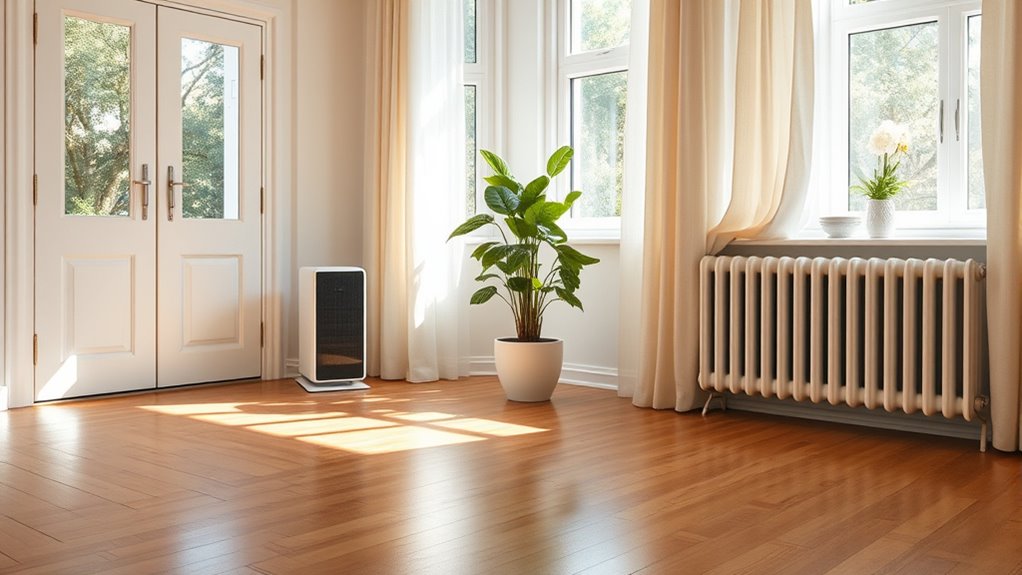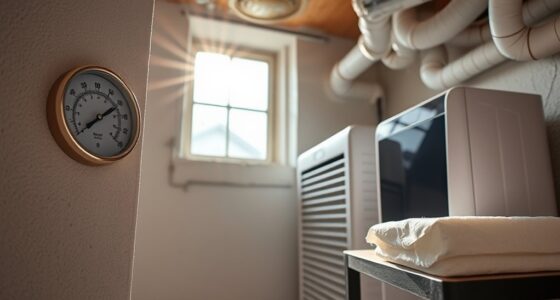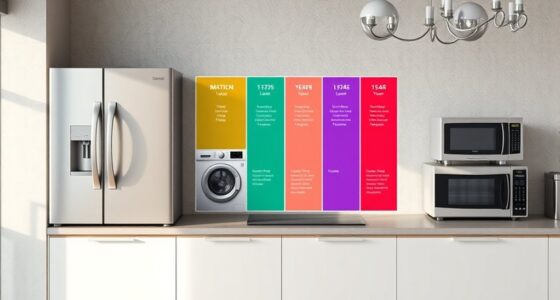Your home can make you sick if you ignore indoor pollutants like dust, mold, and VOCs from cleaning products or paints. Proper ventilation, humidity control, and regular cleaning help reduce these risks. Check and upgrade appliances safely, and handle chemicals carefully to prevent harmful exposure. Staying proactive with maintenance keeps your environment healthy. Want practical tips to improve indoor air quality and keep your family safe? Keep exploring to learn more.
Key Takeaways
- Regularly monitor and control indoor humidity (30-50%) to prevent mold growth and reduce respiratory issues.
- Use HEPA air purifiers and ensure proper ventilation to minimize airborne allergens and pollutants.
- Schedule routine appliance inspections and maintenance to prevent leaks, malfunctions, and safety hazards.
- Properly store and handle chemicals, and choose non-toxic cleaning products to reduce toxic exposure.
- Keep up with HVAC filter changes, exhaust fan use, and pest control to maintain clean, safe indoor air quality.
Identifying Common Indoor Air Pollutants
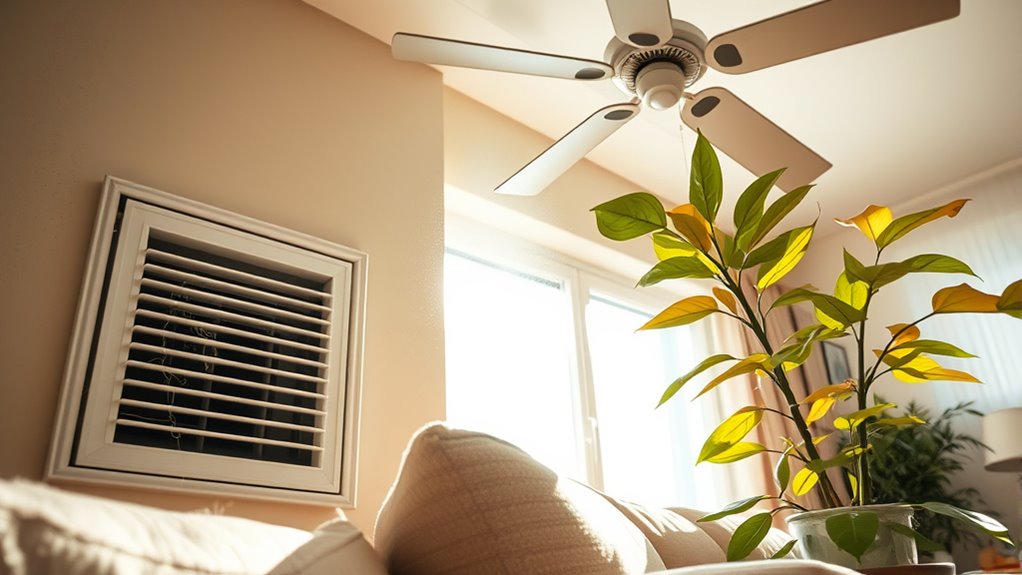
Have you ever wondered what invisible toxins might be lurking in your home’s air? Recognizing common indoor air pollutants is vital for maintaining a healthy environment. Air purifier effectiveness varies depending on the pollutants you face; some models better target airborne particles, while others reduce chemical emissions. VOC emission sources, such as household cleaning products, paints, and new furniture, release volatile organic compounds that can cause health issues. You might also encounter dust, pet dander, mold spores, and smoke, all of which contribute to poor indoor air quality. Identifying these sources helps you choose the right air purifier and take steps to minimize exposure. Additionally, the presence of air quality monitoring devices can help you assess and manage indoor pollution levels more effectively. Regularly monitoring your home’s air quality allows you to address pollutants early, ensuring your living space remains safe and healthy.
Maintaining Proper Ventilation and Air Flow

Proper ventilation is crucial for maintaining good indoor air quality because it helps remove pollutants and bring in fresh air. To achieve this, incorporate natural ventilation by opening windows and doors daily, especially when weather permits. Using exhaust fans in kitchens and bathrooms also enhances airflow and prevents stale air buildup. Additionally, consider air filtration systems with HEPA filters to trap airborne particles, improving overall air quality. Regularly maintaining these systems ensures they work effectively. Proper air flow reduces indoor pollutants, prevents the accumulation of dust, and minimizes indoor odors. Enhancing ventilation through consistent practices is a simple yet essential step toward reducing indoor air contaminants and promoting your well-being.
Managing Humidity and Preventing Mold Growth

Controlling indoor moisture is key to preventing mold growth, so you should monitor humidity levels regularly. Good ventilation strategies help keep excess moisture out of your home, making it harder for mold to develop. Keep an eye out for signs of mold early, so you can address problems before they spread. Additionally, incorporating sound healing science techniques, such as using specific frequencies, can promote a healthier indoor environment by reducing stress-related moisture buildup.
Controlling Indoor Moisture
Maintaining the right indoor humidity levels is essential for preventing mold growth and ensuring a healthy living environment. Proper moisture control helps improve air quality by reducing excess dampness that fosters mold and dust mites. Use a hygrometer to monitor humidity, aiming for 30-50%. Ventilate regularly, especially in areas prone to moisture, like the bathroom and kitchen. Fix leaks promptly and use exhaust fans to remove excess moisture from cooking, bathing, and laundry. Keep your home dry by wiping down wet surfaces and avoiding overwatering plants. Dehumidifiers can help in damp spaces, maintaining ideal humidity levels. Regularly inspecting areas susceptible to mold growth ensures early detection and prevents larger issues. By actively managing indoor moisture, you reduce mold risk and improve air quality, creating a healthier, more comfortable home for you and your family.
Ventilation Strategies Effectiveness
Effective ventilation plays a vital role in managing indoor humidity and preventing mold growth. Proper air exchange helps remove excess moisture and stale air, reducing mold risks. Ventilation design should prioritize balanced airflow across all rooms, especially damp areas like bathrooms and kitchens. To enhance effectiveness, consider the following:
| Ventilation Type | Suitable For | Benefits |
|---|---|---|
| Mechanical Ventilation | Humid climates | Consistent air exchange |
| Exhaust Fans | Bathrooms, kitchens | Rapid moisture removal |
| Natural Ventilation | Mild climates | Cost-effective, passive flow |
Choosing the right strategy ensures ideal humidity levels, minimizing mold development and improving indoor air quality. Properly designed ventilation systems can markedly impact your home’s health by controlling moisture and promoting fresh air circulation. Additionally, leveraging AI-driven diagnostics can help identify optimal ventilation solutions tailored to your home’s specific needs.
Detecting Mold Early
How can you spot the early signs of mold before it becomes a serious problem? Keep an eye out for musty odors, discolored spots, and persistent condensation. These are clues that mold growth may be starting due to excess moisture. To stay ahead, focus on moisture control by:
- Checking for leaks around pipes, windows, and roofs regularly.
- Using dehumidifiers in damp areas like basements and bathrooms.
- Ventilating spaces properly, especially after showers or cooking.
- Regularly inspecting areas with high humidity, as mold spores can begin to grow even with minimal moisture.
Regular Cleaning to Minimize Dust and Allergens
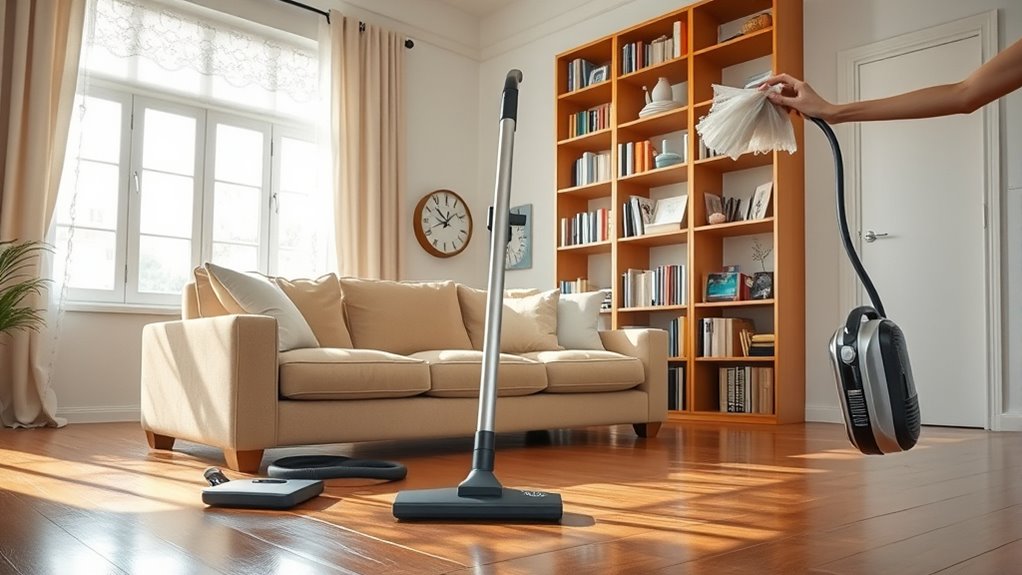
Regular cleaning plays a crucial role in reducing dust and allergens that can accumulate in your home. By dusting surfaces regularly and vacuuming with a HEPA filter, you minimize dust mite populations and prevent allergen buildup. Using an air purifier benefits your indoor air quality by capturing airborne particles, further supporting dust mite control. Don’t forget to wash bedding, curtains, and plush toys frequently, as these are common allergen reservoirs. Keeping floors clean and clutter to a minimum also helps reduce trapped dust and allergens. Incorporating analytical cookies to monitor your home’s air quality can help identify problem areas and improve cleaning routines. Consistent cleaning not only improves your home’s air quality but also creates a healthier environment, especially for allergy sufferers or those with respiratory issues. Taking these steps can make a noticeable difference in how comfortable and safe your home feels.
Inspecting and Upgrading Home Appliances Safely

You should regularly check your appliances’ safety features to prevent accidents and guarantee they’re functioning properly. Upgrading old equipment can improve efficiency and reduce fire risks, so consider replacing outdated units. Always follow proper maintenance practices to keep your appliances safe and in good working order. Additionally, inspecting the home theatre projector for proper calibration and functionality can help ensure optimal performance and safety.
Checking Appliance Safety Features
Ensuring your home appliances are equipped with up-to-date safety features is essential for preventing accidents and maintaining a secure living environment. Regular home appliance inspection helps identify potential hazards early. To do this effectively:
- Check that all appliances have functioning safety switches, such as automatic shut-offs for ovens and dryers.
- Verify that cords and plugs are undamaged, and avoid overloading outlets.
- Make certain that smoke and carbon monoxide detectors are installed near appliances that produce fumes or heat, and test them monthly.
- Incorporate data-driven strategies to monitor and improve appliance safety over time.
Upgrading Old Equipment
Have you ever considered how outdated appliances might compromise your home’s safety? Old heating systems or appliances can pose fire hazards or leak harmful gases. Upgrading to modern, energy-efficient equipment reduces these risks and improves safety. Consider installing smart thermostats, which allow you to monitor and control your home’s temperature remotely, preventing overheating and saving energy. Replacing outdated lighting with energy-efficient bulbs not only cuts costs but also minimizes fire risks associated with old wiring or faulty fixtures. When upgrading, always ensure new appliances meet safety standards and have proper installation. Dispose of old equipment responsibly to avoid environmental hazards. Regularly inspecting and replacing outdated appliances keeps your home safer, healthier, and more energy-efficient. Additionally, practicing good creative practice can foster innovative solutions for maintaining and improving your home. Stay proactive to protect your loved ones and improve your home’s safety and efficiency.
Proper Maintenance Practices
Regularly inspecting your home appliances is essential for safe operation and longevity. Start with your HVAC system: check filters monthly, ensure vents are clear, and schedule professional tune-ups annually to keep it running efficiently. Next, examine appliances like your refrigerator and water heater for leaks or corrosion, replacing parts as needed. Don’t forget pest control appliances—inspect for signs of pests or damage, and clean regularly to prevent infestations that could compromise air quality. Finally, test smoke and carbon monoxide detectors, replacing batteries annually. Upgrading outdated appliances when necessary reduces energy waste and safety risks. By following these practices, you maintain a healthier home environment, prevent costly repairs, and guarantee your appliances operate safely for years to come.
Ensuring Safe Use of Chemicals and Cleaning Products

Are you aware of the potential dangers lurking in common cleaning products? To guarantee chemical safety, always read cleaning product labels carefully. Labels provide essential information about proper use, potential hazards, and first aid measures. Store chemicals out of children’s reach and avoid mixing different products, especially those containing bleach or ammonia, which can produce toxic fumes. Ventilate rooms well during and after cleaning to reduce inhalation risks. Consider switching to eco-friendly, non-toxic alternatives that are safer for your family and the environment. Always wear gloves and, if necessary, masks to protect your skin and respiratory system. By paying close attention to labels and handling chemicals responsibly, you minimize health risks and maintain a healthier, safer home.
Frequently Asked Questions
How Often Should I Change My Home’s Air Filters?
You should change your home’s air filters regularly to guarantee ideal HVAC maintenance and air quality. Typically, replacing filters every 1 to 3 months helps maintain proper airflow and prolongs filter lifespan. Factors like pets, allergies, and air pollution may require more frequent changes. Keeping up with this routine reduces dust, allergens, and contaminants, creating a healthier environment and preventing strain on your HVAC system. Stay proactive to keep your home safe and comfortable.
What Are the Signs of Hidden Mold in My House?
Hidden mold can be a silent killer, causing mold-related health concerns you might overlook. Look for musty odors, water stains, or persistent allergies that won’t go away. You might also notice visible black or green spots in hidden corners or behind walls. Detecting hidden mold is essential for your health. If you suspect it, don’t delay—get professional testing to identify mold and prevent serious health issues.
Which Household Appliances Are Most Energy-Efficient and Safest?
When choosing household appliances, look for Energy Star ratings to guarantee energy efficiency. These appliances use less power, saving you money and reducing environmental impact. Prioritize appliance safety by selecting models with safety features like automatic shutoff and sturdy construction. Always follow manufacturer instructions for safe operation. By choosing energy-efficient and safe appliances, you create a healthier home environment while protecting your family and the planet.
How Can I Improve Indoor Air Quality Without Costly Upgrades?
Ever wonder how to breathe easier at home? You can improve indoor air quality by using air purifiers to filter out pollutants and allergens. Adding houseplants not only beautifies your space but also naturally cleans the air. Regularly ventilate rooms by opening windows and cleaning filters. These simple, cost-effective steps can make a big difference, helping you enjoy fresher, healthier indoor air every day.
Are Natural Cleaning Products as Effective as Chemical Ones?
Natural cleaning products are often just as effective as chemical ones, especially when you choose green cleaning options that are toxin free. They remove dirt and grime without harsh fumes or residues, making your home healthier. You can use simple ingredients like vinegar, baking soda, and lemon for many tasks. By switching to toxin free products, you protect your family and the environment without sacrificing cleaning power.
Conclusion
Your home can be a sanctuary or a silent threat if you neglect its health. By keeping the air pure, controlling humidity, and choosing your cleaning products wisely, you’re nurturing a safe haven where health can flourish. Think of your house as a garden—you hold the tools to prune away dangers and cultivate a space filled with vigor. Take charge today, and transform your home into a refuge that breathes life into every moment.
